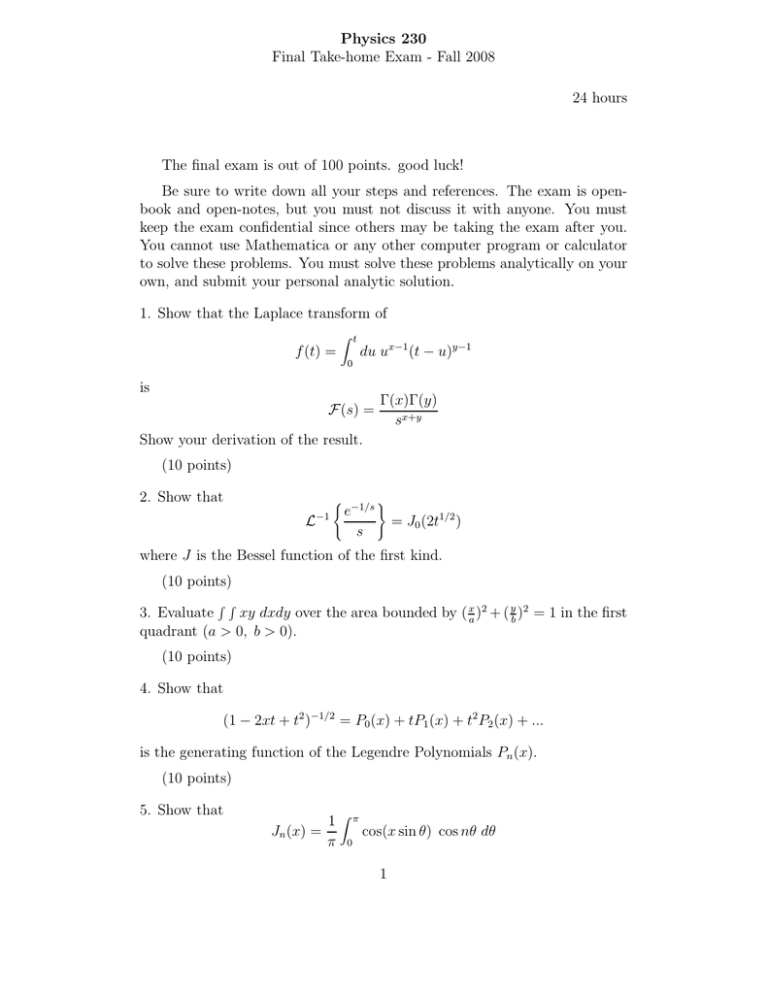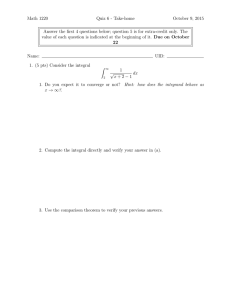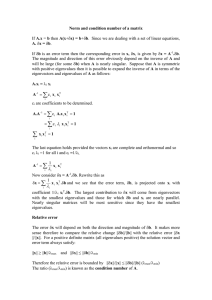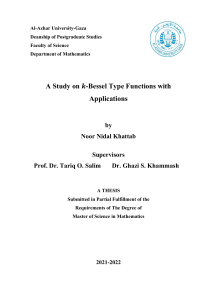Physics 230 Final Take-home Exam - Fall 2008 24 hours
advertisement

Physics 230 Final Take-home Exam - Fall 2008 24 hours The final exam is out of 100 points. good luck! Be sure to write down all your steps and references. The exam is openbook and open-notes, but you must not discuss it with anyone. You must keep the exam confidential since others may be taking the exam after you. You cannot use Mathematica or any other computer program or calculator to solve these problems. You must solve these problems analytically on your own, and submit your personal analytic solution. 1. Show that the Laplace transform of f (t) = Z t du ux−1 (t − u)y−1 0 is F (s) = Γ(x)Γ(y) sx+y Show your derivation of the result. (10 points) 2. Show that L −1 ( e−1/s s ) = J0 (2t1/2 ) where J is the Bessel function of the first kind. (10 points) 3. Evaluate xy dxdy over the area bounded by ( xa )2 + ( yb )2 = 1 in the first quadrant (a > 0, b > 0). RR (10 points) 4. Show that (1 − 2xt + t2 )−1/2 = P0 (x) + tP1 (x) + t2 P2 (x) + ... is the generating function of the Legendre Polynomials Pn (x). (10 points) 5. Show that Jn (x) = 1Zπ cos(x sin θ) cos nθ dθ π 0 1 for n even. (10 points) 6. Derive the relation Jν (x)Yν+1 (x) − Jν+1 (x)Yν (x) = − 2 πx where Y is the Bessel function of the second kind. (10 points) 7. Use contour integration to evaluate Z ∞ −∞ sin2 x dx x2 (10 points) 8. Solve the heat equation 1 ∂u ∂2u = 2 2 ∂x α ∂t with 0 ≤ x < ∞ and t > 0, subject to the conditions u(0, t) = u0 δ(t), u(x, 0) = 0 and limx→∞ u(x, t) = 0. Use the method of Laplace Transform. Give a physical interpretation to this problem. (10 points) 9. Use the “log trick” mentioned in the handouts and McQuarrie page 938 to evaluate the integral Z ∞ dx 2 x + 2x + 2 0 (10 points) 10. Using the Laplace transform definition of a characteristic function, show that the characteristic function of f (t), the probability distribution of the time of the k th radioactive decay in a sample, is given by φ(s) = λk (λ + s)k where λ is the exponential parameter in the time distribution of a single radioactive decay. Use your result for φ(s) to find f (t). (10 points) 2






